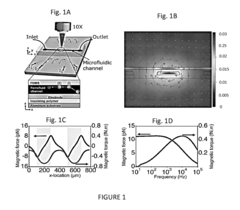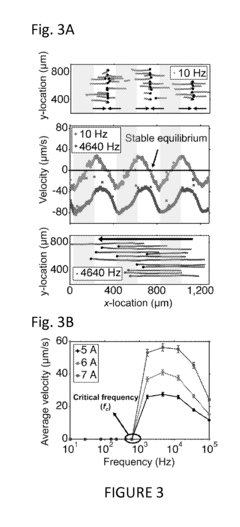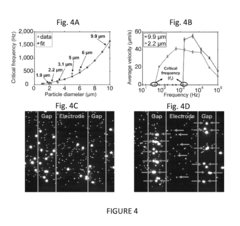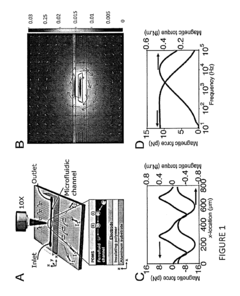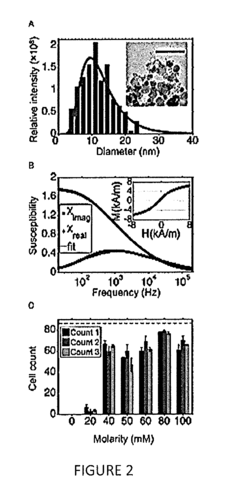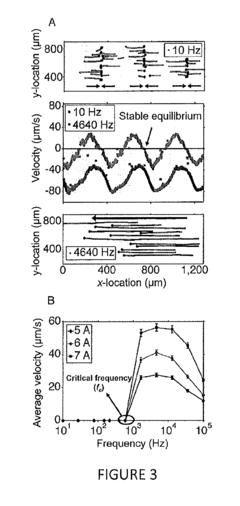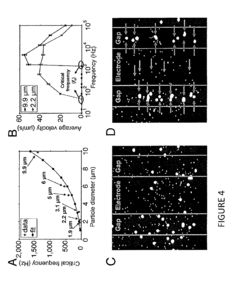How to Integrate Ferrofluid for Cutting-Edge Scientific Studies?
JUL 9, 20259 MIN READ
Generate Your Research Report Instantly with AI Agent
Patsnap Eureka helps you evaluate technical feasibility & market potential.
Ferrofluid Integration Background and Objectives
Ferrofluids, discovered in the 1960s by NASA's Steve Papell, have evolved from a space-age curiosity to a versatile material with diverse applications in cutting-edge scientific studies. These unique liquids, composed of nanoscale ferromagnetic particles suspended in a carrier fluid, exhibit remarkable responsiveness to magnetic fields while maintaining fluid properties. The integration of ferrofluids into scientific research has gained significant momentum over the past decades, driven by advancements in nanotechnology and materials science.
The primary objective of integrating ferrofluids into cutting-edge scientific studies is to harness their unique properties for novel applications and to push the boundaries of existing technologies. Researchers aim to exploit the magnetic and fluid dynamics of ferrofluids to develop innovative solutions in fields ranging from biomedicine to energy harvesting. By understanding and controlling the behavior of ferrofluids at the nanoscale, scientists seek to create more efficient and responsive systems that can adapt to external stimuli.
One of the key trends in ferrofluid integration is the development of smart materials and adaptive systems. Scientists are exploring ways to incorporate ferrofluids into composite materials that can change shape, stiffness, or other properties in response to magnetic fields. This research has potential applications in soft robotics, adaptive optics, and self-healing materials. Additionally, the biocompatibility of certain ferrofluids has opened up new avenues in targeted drug delivery and medical imaging, where precise control over the movement and localization of therapeutic agents is crucial.
The evolution of ferrofluid technology has been marked by significant milestones, including the development of stable, biocompatible ferrofluids and the ability to functionalize magnetic nanoparticles for specific applications. Recent advancements in synthesis techniques have allowed for greater control over particle size, distribution, and magnetic properties, enabling the creation of ferrofluids tailored for specific scientific studies.
As research progresses, the integration of ferrofluids faces both opportunities and challenges. The interdisciplinary nature of ferrofluid applications requires collaboration between physicists, chemists, materials scientists, and engineers to fully realize their potential. Overcoming challenges such as long-term stability, scalability, and precise control over ferrofluid behavior in complex environments remains a focus of ongoing research efforts.
Looking ahead, the integration of ferrofluids in cutting-edge scientific studies is expected to contribute to breakthroughs in various fields. From enhancing the efficiency of heat transfer systems to enabling new paradigms in microfluidics and lab-on-a-chip devices, ferrofluids hold promise for transformative applications. As researchers continue to explore and expand the capabilities of these remarkable materials, the objectives of ferrofluid integration will likely evolve, driving innovation and opening new frontiers in scientific research.
The primary objective of integrating ferrofluids into cutting-edge scientific studies is to harness their unique properties for novel applications and to push the boundaries of existing technologies. Researchers aim to exploit the magnetic and fluid dynamics of ferrofluids to develop innovative solutions in fields ranging from biomedicine to energy harvesting. By understanding and controlling the behavior of ferrofluids at the nanoscale, scientists seek to create more efficient and responsive systems that can adapt to external stimuli.
One of the key trends in ferrofluid integration is the development of smart materials and adaptive systems. Scientists are exploring ways to incorporate ferrofluids into composite materials that can change shape, stiffness, or other properties in response to magnetic fields. This research has potential applications in soft robotics, adaptive optics, and self-healing materials. Additionally, the biocompatibility of certain ferrofluids has opened up new avenues in targeted drug delivery and medical imaging, where precise control over the movement and localization of therapeutic agents is crucial.
The evolution of ferrofluid technology has been marked by significant milestones, including the development of stable, biocompatible ferrofluids and the ability to functionalize magnetic nanoparticles for specific applications. Recent advancements in synthesis techniques have allowed for greater control over particle size, distribution, and magnetic properties, enabling the creation of ferrofluids tailored for specific scientific studies.
As research progresses, the integration of ferrofluids faces both opportunities and challenges. The interdisciplinary nature of ferrofluid applications requires collaboration between physicists, chemists, materials scientists, and engineers to fully realize their potential. Overcoming challenges such as long-term stability, scalability, and precise control over ferrofluid behavior in complex environments remains a focus of ongoing research efforts.
Looking ahead, the integration of ferrofluids in cutting-edge scientific studies is expected to contribute to breakthroughs in various fields. From enhancing the efficiency of heat transfer systems to enabling new paradigms in microfluidics and lab-on-a-chip devices, ferrofluids hold promise for transformative applications. As researchers continue to explore and expand the capabilities of these remarkable materials, the objectives of ferrofluid integration will likely evolve, driving innovation and opening new frontiers in scientific research.
Market Analysis for Ferrofluid Applications
The ferrofluid market has been experiencing significant growth in recent years, driven by increasing applications across various industries. The global ferrofluid market size was valued at approximately $57 million in 2020 and is projected to reach $73 million by 2025, growing at a CAGR of 5.1% during the forecast period. This growth is primarily attributed to the rising demand for ferrofluids in electronic devices, medical applications, and mechanical engineering.
In the electronics sector, ferrofluids are extensively used in loudspeakers, hard drives, and other audio equipment to enhance performance and reduce friction. The growing consumer electronics market, particularly in developing economies, is expected to fuel the demand for ferrofluids in this segment. Additionally, the increasing adoption of ferrofluids in semiconductor manufacturing processes for wafer polishing and chip cooling applications is contributing to market expansion.
The medical field represents another significant growth area for ferrofluids. Their unique properties make them ideal for targeted drug delivery, magnetic hyperthermia for cancer treatment, and contrast agents in magnetic resonance imaging (MRI). The ongoing research and development in these areas are expected to create new opportunities for ferrofluid applications in the healthcare sector.
In mechanical engineering, ferrofluids are utilized in sealing systems, dampers, and bearings to improve efficiency and reduce maintenance requirements. The automotive and aerospace industries are increasingly incorporating ferrofluid-based technologies in their products, driving market growth in this segment.
Geographically, North America and Europe currently dominate the ferrofluid market due to their advanced technological infrastructure and significant investments in research and development. However, the Asia-Pacific region is expected to witness the highest growth rate in the coming years, fueled by rapid industrialization, increasing electronic manufacturing activities, and growing healthcare expenditure in countries like China and India.
Key players in the ferrofluid market include Ferrotec Holdings Corporation, Liquid Research Limited, American Elements, and Ioniqa Technologies. These companies are focusing on product innovation and strategic partnerships to maintain their competitive edge and expand their market presence.
Despite the positive outlook, challenges such as high production costs and limited awareness about ferrofluid applications in emerging markets could potentially hinder market growth. However, ongoing research into new applications and efforts to reduce production costs are expected to mitigate these challenges and drive further market expansion in the coming years.
In the electronics sector, ferrofluids are extensively used in loudspeakers, hard drives, and other audio equipment to enhance performance and reduce friction. The growing consumer electronics market, particularly in developing economies, is expected to fuel the demand for ferrofluids in this segment. Additionally, the increasing adoption of ferrofluids in semiconductor manufacturing processes for wafer polishing and chip cooling applications is contributing to market expansion.
The medical field represents another significant growth area for ferrofluids. Their unique properties make them ideal for targeted drug delivery, magnetic hyperthermia for cancer treatment, and contrast agents in magnetic resonance imaging (MRI). The ongoing research and development in these areas are expected to create new opportunities for ferrofluid applications in the healthcare sector.
In mechanical engineering, ferrofluids are utilized in sealing systems, dampers, and bearings to improve efficiency and reduce maintenance requirements. The automotive and aerospace industries are increasingly incorporating ferrofluid-based technologies in their products, driving market growth in this segment.
Geographically, North America and Europe currently dominate the ferrofluid market due to their advanced technological infrastructure and significant investments in research and development. However, the Asia-Pacific region is expected to witness the highest growth rate in the coming years, fueled by rapid industrialization, increasing electronic manufacturing activities, and growing healthcare expenditure in countries like China and India.
Key players in the ferrofluid market include Ferrotec Holdings Corporation, Liquid Research Limited, American Elements, and Ioniqa Technologies. These companies are focusing on product innovation and strategic partnerships to maintain their competitive edge and expand their market presence.
Despite the positive outlook, challenges such as high production costs and limited awareness about ferrofluid applications in emerging markets could potentially hinder market growth. However, ongoing research into new applications and efforts to reduce production costs are expected to mitigate these challenges and drive further market expansion in the coming years.
Current Challenges in Ferrofluid Integration
Despite the promising potential of ferrofluids in cutting-edge scientific studies, their integration faces several significant challenges. One of the primary obstacles is the stability of ferrofluids under various experimental conditions. Ferrofluids are known to be sensitive to external magnetic fields, temperature changes, and chemical environments, which can lead to aggregation, sedimentation, or loss of magnetic properties. This instability poses difficulties in maintaining consistent performance across different experimental setups and over extended periods.
Another challenge lies in the precise control and manipulation of ferrofluids at the microscale and nanoscale levels. While ferrofluids respond to magnetic fields, achieving fine-tuned control for intricate scientific applications remains a complex task. This is particularly crucial in microfluidic devices and nanoparticle-based sensing systems, where precise spatial and temporal control of ferrofluid behavior is essential for accurate results.
The biocompatibility of ferrofluids presents a significant hurdle in biomedical applications. Although progress has been made in developing biocompatible ferrofluids, concerns remain regarding their long-term effects on living tissues and potential toxicity. This challenge is particularly relevant in areas such as targeted drug delivery, magnetic hyperthermia, and MRI contrast enhancement, where the interaction between ferrofluids and biological systems is critical.
Integration of ferrofluids with existing scientific instruments and methodologies poses another set of challenges. Many current analytical and experimental techniques are not optimized for ferrofluid-based systems, requiring modifications or entirely new approaches. This includes adapting imaging techniques, developing new measurement protocols, and creating specialized equipment capable of handling the unique properties of ferrofluids.
The scalability of ferrofluid-based technologies from laboratory settings to practical, large-scale applications remains a significant challenge. Issues such as cost-effective production of high-quality ferrofluids, maintaining their properties during scale-up, and ensuring consistent performance in diverse real-world environments need to be addressed. This scalability challenge is particularly evident in fields like energy harvesting, where the transition from small-scale demonstrations to commercially viable systems is crucial.
Lastly, the interdisciplinary nature of ferrofluid research presents a challenge in itself. Effective integration of ferrofluids in cutting-edge scientific studies requires collaboration across various fields, including physics, chemistry, materials science, and engineering. Bridging the knowledge gaps between these disciplines and fostering effective communication and collaboration among researchers from different backgrounds is essential for overcoming the technical challenges and realizing the full potential of ferrofluids in advanced scientific applications.
Another challenge lies in the precise control and manipulation of ferrofluids at the microscale and nanoscale levels. While ferrofluids respond to magnetic fields, achieving fine-tuned control for intricate scientific applications remains a complex task. This is particularly crucial in microfluidic devices and nanoparticle-based sensing systems, where precise spatial and temporal control of ferrofluid behavior is essential for accurate results.
The biocompatibility of ferrofluids presents a significant hurdle in biomedical applications. Although progress has been made in developing biocompatible ferrofluids, concerns remain regarding their long-term effects on living tissues and potential toxicity. This challenge is particularly relevant in areas such as targeted drug delivery, magnetic hyperthermia, and MRI contrast enhancement, where the interaction between ferrofluids and biological systems is critical.
Integration of ferrofluids with existing scientific instruments and methodologies poses another set of challenges. Many current analytical and experimental techniques are not optimized for ferrofluid-based systems, requiring modifications or entirely new approaches. This includes adapting imaging techniques, developing new measurement protocols, and creating specialized equipment capable of handling the unique properties of ferrofluids.
The scalability of ferrofluid-based technologies from laboratory settings to practical, large-scale applications remains a significant challenge. Issues such as cost-effective production of high-quality ferrofluids, maintaining their properties during scale-up, and ensuring consistent performance in diverse real-world environments need to be addressed. This scalability challenge is particularly evident in fields like energy harvesting, where the transition from small-scale demonstrations to commercially viable systems is crucial.
Lastly, the interdisciplinary nature of ferrofluid research presents a challenge in itself. Effective integration of ferrofluids in cutting-edge scientific studies requires collaboration across various fields, including physics, chemistry, materials science, and engineering. Bridging the knowledge gaps between these disciplines and fostering effective communication and collaboration among researchers from different backgrounds is essential for overcoming the technical challenges and realizing the full potential of ferrofluids in advanced scientific applications.
Existing Ferrofluid Integration Techniques
01 Composition and preparation of ferrofluids
Ferrofluids are colloidal suspensions of magnetic nanoparticles in a carrier fluid. They are typically composed of magnetite or other ferromagnetic materials coated with a surfactant to prevent agglomeration. The preparation process involves careful control of particle size and distribution to maintain stability and magnetic properties.- Composition and preparation of ferrofluids: Ferrofluids are colloidal suspensions of magnetic nanoparticles in a carrier fluid. They typically consist of magnetite or other ferromagnetic materials coated with surfactants to prevent agglomeration. The preparation process involves careful control of particle size, surfactant selection, and carrier fluid properties to achieve stable and responsive ferrofluids.
- Applications in sealing and lubrication: Ferrofluids are widely used in sealing and lubrication applications, particularly in rotating shaft seals and bearings. Their unique properties allow them to form liquid seals that can be controlled by magnetic fields, providing effective containment of gases and liquids while reducing friction and wear in mechanical systems.
- Thermal management and heat transfer: Ferrofluids exhibit enhanced heat transfer properties due to their magnetic nature. They are used in cooling systems for electronic devices, transformers, and other heat-generating equipment. The ability to manipulate ferrofluids with magnetic fields allows for targeted cooling and improved thermal management in various applications.
- Sensing and measurement applications: The magnetic properties of ferrofluids make them useful in various sensing and measurement applications. They are employed in accelerometers, tilt sensors, and liquid level sensors. Ferrofluids can also be used in magnetic resonance imaging (MRI) as contrast agents and in magnetic particle imaging for medical diagnostics.
- Damping and vibration control: Ferrofluids are utilized in damping systems and vibration control applications. Their ability to change viscosity in response to magnetic fields allows for adaptive damping in mechanical systems, shock absorbers, and acoustic devices. This property is particularly useful in improving the performance of speakers and other audio equipment.
02 Applications in sealing and lubrication
Ferrofluids are widely used in sealing and lubrication applications, particularly in rotating shaft seals and bearings. They provide a unique combination of liquid properties with magnetic responsiveness, allowing for dynamic sealing and reduced friction in various mechanical systems.Expand Specific Solutions03 Thermal management and cooling systems
Ferrofluids are employed in thermal management solutions, particularly in electronic cooling systems. Their ability to be manipulated by magnetic fields allows for enhanced heat transfer and targeted cooling in compact electronic devices and power systems.Expand Specific Solutions04 Sensor and actuator technologies
Ferrofluids are utilized in various sensor and actuator technologies, including accelerometers, inertial sensors, and haptic feedback devices. Their unique magnetic properties enable precise control and measurement of motion and force in compact designs.Expand Specific Solutions05 Medical and biomedical applications
Ferrofluids have emerging applications in medical and biomedical fields, including targeted drug delivery, magnetic hyperthermia for cancer treatment, and contrast agents for magnetic resonance imaging (MRI). Their ability to be manipulated by external magnetic fields offers potential for non-invasive therapies and diagnostics.Expand Specific Solutions
Key Players in Ferrofluid Research and Development
The integration of ferrofluid for cutting-edge scientific studies is in a nascent stage, with growing market potential as researchers explore its unique properties. The technology's maturity is still developing, with academic institutions leading the charge. Key players like The Regents of the University of California, Yale University, and École Polytechnique Fédérale de Lausanne are at the forefront of research. Companies such as Ancera LLC and MagnaMedics GmbH are exploring commercial applications, indicating a transition from pure research to practical implementations. The market size is expanding as ferrofluid finds applications in diverse fields, from biomedicine to engineering, attracting interest from both academic and industrial sectors.
The Regents of the University of California
Technical Solution: The University of California has developed innovative approaches for integrating ferrofluids in scientific studies. They have created a microfluidic platform that uses ferrofluids for precise manipulation and sorting of cells and particles [1]. This system employs magnetic fields to control the ferrofluid, allowing for high-throughput and label-free separation of biological samples. Additionally, they have explored the use of ferrofluids in heat transfer applications, developing nanofluid coolants with enhanced thermal conductivity for more efficient cooling systems in electronics and energy production [2]. The university has also investigated ferrofluid-based sensors for detecting environmental pollutants and biomolecules with high sensitivity [3].
Strengths: Cutting-edge microfluidic technology, versatile applications in biotechnology and environmental sensing. Weaknesses: May require specialized equipment and expertise for implementation.
Yale University
Technical Solution: Yale University has made significant strides in integrating ferrofluids for advanced scientific studies. Their research focuses on developing novel ferrofluid-based materials with unique magnetic and optical properties. They have created "photonic ferrofluids" that change color in response to magnetic fields, offering potential applications in displays and sensors [4]. Yale researchers have also explored the use of ferrofluids in soft robotics, creating magnetically responsive actuators that can perform complex movements [5]. Additionally, they have investigated the potential of ferrofluids in biomedical applications, such as targeted drug delivery systems and magnetic hyperthermia for cancer treatment [6].
Strengths: Innovative materials with multifunctional properties, potential for breakthrough applications in optics and medicine. Weaknesses: Some applications may be in early stages of development and require further optimization for practical use.
Innovative Ferrofluid Properties and Mechanisms
Label-Free Cellular Manipulation and Sorting Via Biocompatible Ferrofluids
PatentActiveUS20180128729A1
Innovation
- A microfluidic platform using biocompatible ferrofluids with a microfluidic channel and electrodes that generate a magnetic field pattern, allowing for the controlled manipulation and separation of microparticles and live cells based on size, shape, and elasticity, with high efficiency and rapid separation capabilities.
Label-free cellular manipulation and sorting via biocompatible ferrofluids
PatentActiveUS20120237997A1
Innovation
- A microfluidic platform using biocompatible ferrofluids with a microfluidic channel and electrodes that generate a magnetic field pattern, allowing for the controlled manipulation and separation of microparticles and live cells based on size, shape, and elasticity, with high efficiency and rapid separation capabilities.
Safety and Environmental Considerations
The integration of ferrofluid in cutting-edge scientific studies necessitates careful consideration of safety and environmental factors. Ferrofluids, composed of nanoscale ferromagnetic particles suspended in a carrier fluid, present unique challenges in handling and disposal. Researchers must prioritize personal protective equipment (PPE) when working with ferrofluids, including gloves, goggles, and lab coats to prevent skin contact or inhalation of nanoparticles. Proper ventilation systems in laboratories are crucial to mitigate the risk of airborne particles.
Environmental concerns arise from the potential release of ferrofluids into ecosystems. The nanoparticles in ferrofluids may persist in the environment and potentially bioaccumulate in organisms. Proper containment and disposal protocols are essential to prevent contamination of water sources or soil. Researchers should implement spill response procedures and utilize specialized containment materials designed for nanoparticle cleanup.
Long-term exposure effects of ferrofluids on human health and the environment are not fully understood, necessitating ongoing research and risk assessment. Studies should be conducted to evaluate the potential for nanoparticle migration through biological systems and their impact on various organisms. Additionally, the magnetic properties of ferrofluids may interfere with sensitive electronic equipment, requiring careful management in research settings.
Regulatory compliance is a critical aspect of ferrofluid integration in scientific studies. Researchers must adhere to guidelines set by environmental protection agencies and occupational safety organizations. This includes proper labeling, storage, and transportation of ferrofluids, as well as maintaining detailed records of usage and disposal.
Sustainable practices in ferrofluid research should be encouraged, focusing on minimizing waste generation and exploring recycling options for used materials. Developing eco-friendly ferrofluid formulations with biodegradable carrier fluids or less persistent nanoparticles could mitigate long-term environmental impacts. Collaboration between materials scientists, toxicologists, and environmental experts is crucial to address these challenges comprehensively.
As scientific studies involving ferrofluids advance, it is imperative to establish standardized safety protocols and environmental impact assessments. This proactive approach will ensure responsible innovation while safeguarding human health and ecological balance. Regular training and updates on best practices for ferrofluid handling should be provided to all personnel involved in related research activities.
Environmental concerns arise from the potential release of ferrofluids into ecosystems. The nanoparticles in ferrofluids may persist in the environment and potentially bioaccumulate in organisms. Proper containment and disposal protocols are essential to prevent contamination of water sources or soil. Researchers should implement spill response procedures and utilize specialized containment materials designed for nanoparticle cleanup.
Long-term exposure effects of ferrofluids on human health and the environment are not fully understood, necessitating ongoing research and risk assessment. Studies should be conducted to evaluate the potential for nanoparticle migration through biological systems and their impact on various organisms. Additionally, the magnetic properties of ferrofluids may interfere with sensitive electronic equipment, requiring careful management in research settings.
Regulatory compliance is a critical aspect of ferrofluid integration in scientific studies. Researchers must adhere to guidelines set by environmental protection agencies and occupational safety organizations. This includes proper labeling, storage, and transportation of ferrofluids, as well as maintaining detailed records of usage and disposal.
Sustainable practices in ferrofluid research should be encouraged, focusing on minimizing waste generation and exploring recycling options for used materials. Developing eco-friendly ferrofluid formulations with biodegradable carrier fluids or less persistent nanoparticles could mitigate long-term environmental impacts. Collaboration between materials scientists, toxicologists, and environmental experts is crucial to address these challenges comprehensively.
As scientific studies involving ferrofluids advance, it is imperative to establish standardized safety protocols and environmental impact assessments. This proactive approach will ensure responsible innovation while safeguarding human health and ecological balance. Regular training and updates on best practices for ferrofluid handling should be provided to all personnel involved in related research activities.
Interdisciplinary Applications of Ferrofluids
Ferrofluids, with their unique magnetic properties and fluid characteristics, offer a wide range of interdisciplinary applications across various scientific fields. These colloidal suspensions of magnetic nanoparticles have sparked interest in diverse research areas, leading to innovative studies and potential breakthroughs.
In the field of biomedicine, ferrofluids have shown promise in targeted drug delivery systems. By manipulating the magnetic properties of these fluids, researchers can guide medications to specific areas within the body, potentially improving treatment efficacy and reducing side effects. Additionally, ferrofluids are being explored for their potential in magnetic hyperthermia treatments for cancer, where localized heating of tumor cells can be achieved through the application of an external magnetic field.
Environmental science has also benefited from ferrofluid integration. These magnetic liquids have been utilized in the development of advanced water purification techniques, where they can be used to remove contaminants and heavy metals from water sources. The ability to magnetically separate and recover ferrofluids makes them an attractive option for sustainable water treatment processes.
In the realm of materials science, ferrofluids are being incorporated into smart materials and adaptive structures. Researchers are exploring their use in developing self-healing materials, where the magnetic properties of ferrofluids can be harnessed to repair micro-cracks and damages in various substrates. This technology has potential applications in aerospace, automotive, and construction industries.
The field of microfluidics has seen significant advancements through the integration of ferrofluids. Scientists are developing novel lab-on-a-chip devices that utilize ferrofluids for precise fluid control and manipulation at the microscale. These applications range from miniaturized analytical systems to advanced cell sorting and separation techniques.
Energy research has also benefited from ferrofluid integration. Studies are underway to explore their potential in enhancing the efficiency of solar thermal collectors and improving heat transfer in various energy systems. The unique thermal and magnetic properties of ferrofluids make them attractive candidates for next-generation energy harvesting and conversion technologies.
In the field of robotics and actuators, ferrofluids are being investigated for their potential in creating soft, adaptable structures. Researchers are developing magnetically controlled soft robots and actuators that can change shape and properties in response to external magnetic fields, opening up new possibilities in minimally invasive surgery and adaptive mechanical systems.
In the field of biomedicine, ferrofluids have shown promise in targeted drug delivery systems. By manipulating the magnetic properties of these fluids, researchers can guide medications to specific areas within the body, potentially improving treatment efficacy and reducing side effects. Additionally, ferrofluids are being explored for their potential in magnetic hyperthermia treatments for cancer, where localized heating of tumor cells can be achieved through the application of an external magnetic field.
Environmental science has also benefited from ferrofluid integration. These magnetic liquids have been utilized in the development of advanced water purification techniques, where they can be used to remove contaminants and heavy metals from water sources. The ability to magnetically separate and recover ferrofluids makes them an attractive option for sustainable water treatment processes.
In the realm of materials science, ferrofluids are being incorporated into smart materials and adaptive structures. Researchers are exploring their use in developing self-healing materials, where the magnetic properties of ferrofluids can be harnessed to repair micro-cracks and damages in various substrates. This technology has potential applications in aerospace, automotive, and construction industries.
The field of microfluidics has seen significant advancements through the integration of ferrofluids. Scientists are developing novel lab-on-a-chip devices that utilize ferrofluids for precise fluid control and manipulation at the microscale. These applications range from miniaturized analytical systems to advanced cell sorting and separation techniques.
Energy research has also benefited from ferrofluid integration. Studies are underway to explore their potential in enhancing the efficiency of solar thermal collectors and improving heat transfer in various energy systems. The unique thermal and magnetic properties of ferrofluids make them attractive candidates for next-generation energy harvesting and conversion technologies.
In the field of robotics and actuators, ferrofluids are being investigated for their potential in creating soft, adaptable structures. Researchers are developing magnetically controlled soft robots and actuators that can change shape and properties in response to external magnetic fields, opening up new possibilities in minimally invasive surgery and adaptive mechanical systems.
Unlock deeper insights with Patsnap Eureka Quick Research — get a full tech report to explore trends and direct your research. Try now!
Generate Your Research Report Instantly with AI Agent
Supercharge your innovation with Patsnap Eureka AI Agent Platform!
